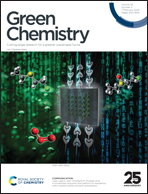Towards a low-carbon future: exploring green urea synthesis for sustainable agriculture†
Abstract
Urea, an important derivative of ammonia, has become an integral part of modern agriculture to meet the increasing global food demand. However, its reliance on depleting fossil fuels impedes efforts toward sustainable agriculture and a low-carbon economy. The synthesis of green urea presents a promising opportunity for carbon fixation and improving sustainability. To materialize this concept and leverage the benefits of the hydrogen economy and carbon capture, this study proposes a strategy to fuel urea production through green ammonia and captured carbon dioxide. To achieve this, a comprehensive process for producing 460 ktons per year of green urea was designed in Aspen Plus V14. The simulated process results were validated against the industrial process, demonstrating a high level of agreement. Subsequently, discounted cash flow analysis and cradle-to-gate life cycle analysis were performed to examine the economic and environmental benefits. The analysis concluded that the design has a minimum urea selling price of USD 0.71 per kg. Electrolysis (64%) and ammonia synthesis (63%) are identified as the most energy- and cost-intensive processes, respectively. Between conventional and green urea synthesis, the latter exhibited a more favorable environmental profile, showcasing a 38% reduction in abiotic fossil fuel depletion and a 16% reduction in global warming potentials. Finally, a sensitivity analysis was conducted, identifying the hydrogen price as a key economic driver. The results indicate that by varying the hydrogen price between USD 3.04 and USD 3.19 per kg, green urea can generate a net present value ranging from 25 million to 75 million USD over a 30-year project lifespan. Overall, the results of this study highlight both the positive and critical aspects of green urea production, providing a quantitative basis for the scientific community and policymakers to guide future research and development necessary for the success of this industry.



 Please wait while we load your content...
Please wait while we load your content...